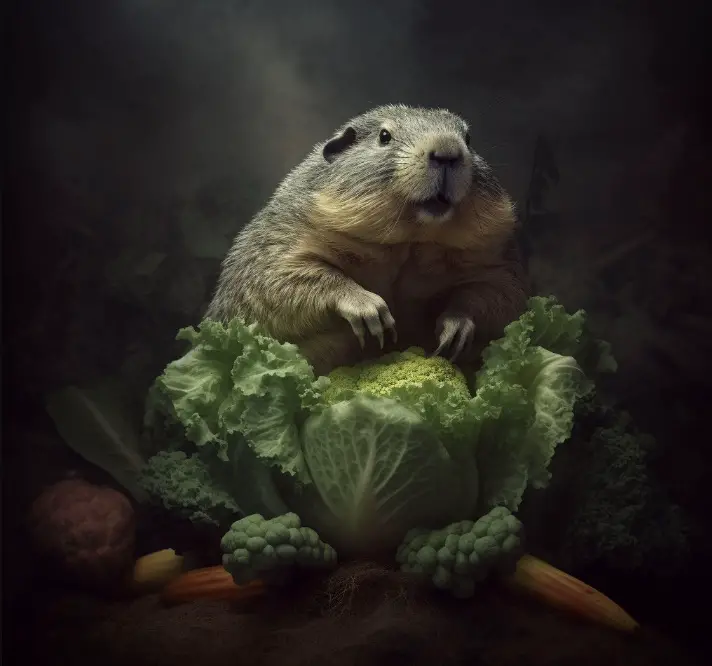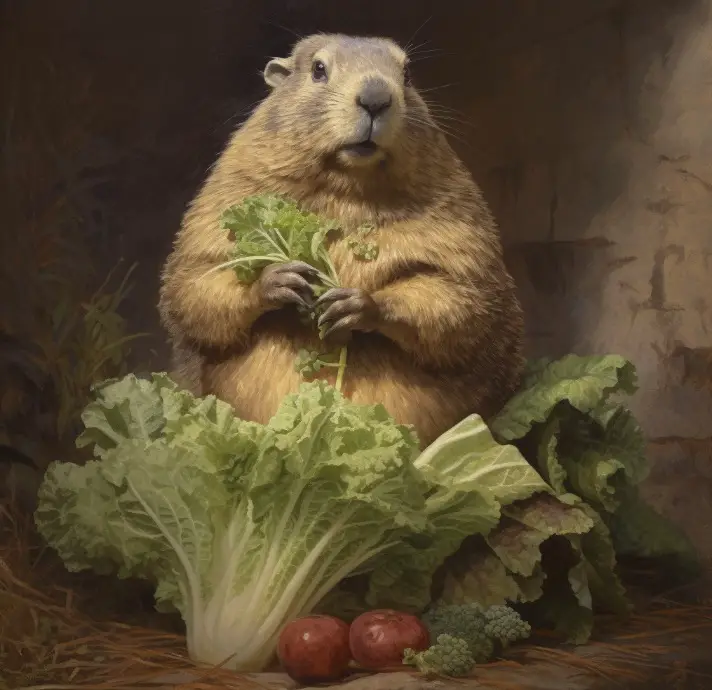As a biologist and an avid gardener, I’ve had my fair share of interactions with various wildlife species, including groundhogs.
These seemingly innocent creatures can wreak havoc in a garden, and I’ve spent countless hours trying to protect my plants from these furry invaders. One of the most common questions I get asked by fellow gardeners is: Do groundhogs eat kale?
The short answer: Yes, groundhogs do eat kale.
However, there’s a lot more to learn about these creatures and their dietary habits. In this blog post, I’ll share my personal experiences and knowledge about groundhogs and their relationship with kale, as well as discuss tips to protect your garden.
Understanding Groundhogs
Groundhog Basics
Before diving into their dietary habits, it’s important to have a basic understanding of groundhogs. Also known as woodchucks, groundhogs (Marmota monax) are a type of marmot and are members of the squirrel family. They are native to North America and are found in a variety of habitats, including forests, meadows, and, unfortunately for us gardeners, residential areas. Groundhogs are burrowers and are known for their extensive tunnel systems.
Groundhog Behavior
Groundhogs are diurnal creatures, meaning they are active during the day, typically in the early morning and late afternoon. They are primarily herbivores, feeding on a wide variety of plants. Groundhogs hibernate during the winter months and emerge in the spring, when food sources become more abundant.
Groundhogs and Kale: A Love Affair
Dietary Preferences
Groundhogs are not picky eaters, and their diet consists of various plants, including grasses, weeds, and garden vegetables. They are particularly fond of leafy greens, such as lettuce, spinach, and, of course, kale. In fact, groundhogs seem to have a special affinity for kale, and I’ve personally witnessed them devouring entire plants in a matter of hours.

Why Kale?
There is no definitive explanation for why groundhogs are so attracted to kale, but it’s likely due to its nutritional content. Kale is high in vitamins and minerals, making it an excellent source of nutrients for these creatures. Additionally, kale has a tender texture that groundhogs find appealing, making it easy for them to consume quickly.
Protecting Your Kale from Groundhogs
Physical Barriers
One of the most effective ways to protect your kale and other garden plants from groundhogs is to install a physical barrier. Fencing is an excellent option, but it’s important to ensure the fence extends at least 12 inches below ground to prevent burrowing. Additionally, the fence should be at least 3 feet tall and have a mesh size of no more than 3 inches.
Repellents
There are a variety of commercial repellents available that can help deter groundhogs from your garden. These products typically contain ingredients such as capsaicin, garlic, or predator urine, which create an unpleasant taste or odor that groundhogs find unpleasant. Be sure to follow the manufacturer’s instructions for proper application.
Trapping and Relocation
In some cases, trapping and relocating a problem groundhog may be the best solution. This method is best left to professionals, as groundhogs can be aggressive when cornered and may carry diseases. Additionally, local laws regarding trapping and relocation may vary, so be sure to consult with your local wildlife agency for guidance.
Read more about how to keep gophers and groundhogs out of your yard here!
The Impact of Groundhogs on Gardens
Damage to Plants
The primary concern for gardeners when it comes to groundhogs is the damage they cause to plants. As mentioned earlier, groundhogs are voracious eaters and can quickly decimate a garden. In addition to consuming the leaves, groundhogs may also dig up and eat the roots of plants, causing even more damage.
Burrowing Dangers
Groundhogs are known for their extensive burrowing, which can cause additional problems for gardeners. Their tunnels can weaken the structural integrity of garden beds, leading to collapses and damage to plants. Additionally, the presence of groundhog burrows may attract other unwanted pests, such as snakes or rodents.
Conclusion: Do Groundhogs Eat Kale and How to Protect Your Garden
In conclusion, yes, groundhogs do eat kale, and they can cause significant damage to your garden. However, with the right strategies in place, you can successfully protect your plants from these furry invaders. Here are 10 key facts to remember about groundhogs and kale:
1. Groundhogs are herbivores that feed on a variety of plants.
2. They have a particular fondness for leafy greens, including kale.
3. Groundhogs are likely attracted to kale due to its nutritional content and tender texture.
4. Physical barriers, such as fencing, can help protect your garden from groundhogs.
5. Repellents containing ingredients like capsaicin or predator urine can deter groundhogs.
6. In some cases, trapping and relocation may be the best solution for problem groundhogs.
7. Groundhogs can cause significant damage to plants by eating leaves and roots.
8. Their burrowing can weaken garden beds and attract other pests.
9. Protecting your kale and other plants from groundhogs requires a combination of preventative measures and active management.
10. Consulting with your local wildlife agency can provide additional guidance on dealing with groundhogs in your area.
FAQs
What is the best bait for groundhogs?
The best bait for groundhogs is fresh fruits and vegetables such as apples, carrots, and sweet potatoes.
What food do groundhogs like the most?
Groundhogs are herbivores and they prefer to eat a variety of vegetation such as grass, clover, dandelion, and other wildflowers. They also enjoy fruits and vegetables such as berries, apples, and carrots.
What vegetables will groundhogs not eat?
Groundhogs are known to eat a wide variety of vegetables, but they are less likely to eat plants with strong odors or tastes, such as garlic, onions, and hot peppers. They also tend to avoid plants with prickly or thorny leaves, such as squash and cucumbers.
What are groundhogs favorite foods?
Groundhogs are herbivores and their favorite foods include clover, alfalfa, dandelions, and other wildflowers. They also eat vegetables such as carrots, lettuce, and beans.
What are the benefits of having a groundhog in your yard?
Groundhogs can help aerate the soil and contribute to the overall health of your yard’s ecosystem. However, they can also cause damage to gardens and structures, so it’s important to weigh the benefits against the potential drawbacks.
What greens do groundhogs eat?
Groundhogs primarily eat greens such as clover, dandelion, and plantain, as well as other plants such as alfalfa, soybeans, and grasses.




